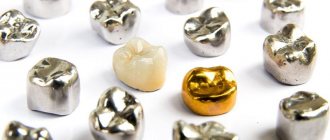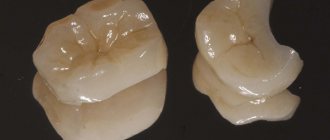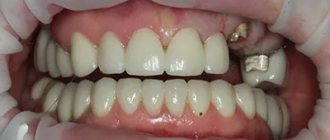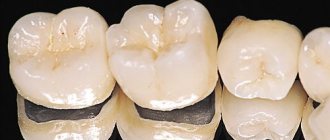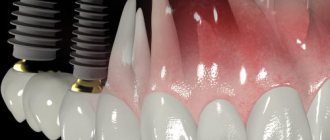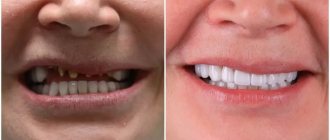Patients who come to a modern dental clinic with a fallen filling, caries, or old worn-out fillings are offered several alternatives:
- New light seal. (It's inexpensive).
- Modern filling with shape restoration (restoration). It costs a little more.
- Ceramic inlay. 3 times more expensive.
It is clear that when choosing inexpensive options, it seems that you can save a lot. But, in this case, this is not the case. During the life of the tab you will have to change at least 5 fillings.
Important! After each filling, less and less tissue remains. And the moment may come when you no longer need a filling, but a crown. And with large chips, you can completely lose a tooth.
What is an inlay in dentistry? This is a microdental prosthesis, a ceramic restoration that completely restores its defect. It looks like part of a ceramic crown. But to install it, you do not need to grind down the enamel or remove the nerve - you only need to remove the tissue affected by caries. The process of microprosthetics occurs. Therefore, dentures with inlays are a less traumatic procedure. It also has many advantages over a filling.
Restoring part of a “dead” tooth with a filling
Before the restoration begins, endodontic treatment (canal treatment of the tooth) is carried out.
If the “nerve” was removed previously, the dentist will check the quality of the root canal treatment and, if necessary, perform re-treatment. We talk about the complexity of endodontic treatment in the article Why it is impossible to give a 100% guarantee for tooth root canal treatment.
If less than 50% of the crown part of the tooth is destroyed, the lost part can be qualitatively restored using composite filling materials.
Modern filling materials allow the dentist to accurately select the color and transparency of the part of the tooth being restored, to recreate the surface structure and anatomical shape, ensuring the correct bite and contact points with neighboring teeth.
Restoring a tooth with a filling requires the dentist to have a good knowledge of dental anatomy and the skill of a sculptor.
The filling will last 5–7 years
What affects the service life of a filling, when and why it will require replacement, you will learn from the article “Why change an old filling if everything is fine and the tooth is not bothering you?”
When salvation is a crown
A dental inlay is a way to save a tooth when it is not possible to fill it. If the damage is significant, then a filling or inlay will not help; more reliable protection will be required - a crown
.
Modern designs are durable and help maintain quality of life when 50% or more
of tooth tissue is lost.
Restoring a tooth with a crown (the price is calculated depending on the chosen material) is reliable protection against recurrent caries. Microparticles of food do not get under the crown, pathogenic microflora do not penetrate, and there is no violation of the marginal seal.
Ceramic, metal-ceramic or zirconium crowns on a tooth will become a reliable covering for the thinned, fragile walls of a natural tooth and will protect them from chipping or breaking.
Modern dentistry makes it possible to bring the shade of the crown as close as possible to the natural shade of the enamel, so the presence of the structure is almost invisible. Installing crowns on chewing teeth is an opportunity not to limit your diet, to eat familiar foods without fear of destruction of the teeth.
Restoring a “dead” tooth with a crown
If more than 50% of a part of a tooth is destroyed by the crown, it is not recommended to restore the lost part with a filling and the dentist will suggest installing a crown. Why does the volume of the part being restored influence the choice of a crown?
Over time, the composite material from which the filling is made gives vertical and horizontal shrinkage, as a result of which the connection of the antagonist teeth into the bite and the distance between adjacent teeth changes.
What problems does shrinkage of the filling lead to are described in detail in the article Why change an old filling if everything is fine and the tooth is not bothering you?
Here we will give just one example: shrinkage of the filling can lead to an increase in the load on the walls of the tooth, which over time will cause them to chip. If the crack goes under the gum (root crack), all that remains is to remove the tooth, and its restoration will require the installation of an implant or prosthetics with support on the adjacent teeth.
Unlike a filling, which is made by a dentist in one oral visit, a crown is made from impressions in a dental laboratory, so it better recreates the anatomical shape and color of the tooth. A crown is stronger than a filling and protects the tooth well from further destruction. When installing a crown, only a small layer of cement with which it is glued shrinks.
Most often, orthopedic dentists offer crowns made of metal ceramics or zirconium dioxide. We talk about choosing crowns in the article How does an orthopedic dentist decide which crown is right for your case?
The crown will last 10–15 years, but may require replacement, most likely for aesthetic reasons: receding gums lead to exposure of the edge of the crown. The edge of the metal-ceramic crown is especially noticeable on teeth in the “smile zone” (the first 5–6 teeth on each side).
A filling cannot be crowned
Many patients are still wildly afraid of crowns, and persistently ask for another filling to solve the problem.
Our doctors encounter such requests in 70% of consultations. The doctor, of course, can take into account the patient’s request and give him a filling that is good, reliable, and of high quality.
But other statistics show that patients who insist on having a filling installed return to the clinic as soon as possible, but for inlays and crowns.
There are many cases when the wall of a “dead” tooth, restored by filling, breaks off, and the chip goes under the gum, and this leads to tooth loss or removal! In most such cases, the tooth can be saved by protecting it with a crown in time.
As a result, it would be possible to avoid wasting time on visits to the doctor, save nerves and money, if you take into account the recommendations of the attending physician in a timely manner.
Using our patient as an example, let’s consider this situation.
The use of pin and stump inlays when restoring “dead” teeth
At the beginning of the article, we said that removing the nerve (pulp) deprives the tooth tissue of recharge. In addition to deteriorating the adhesion of dental materials, removing the nerve makes the tooth tissue dry and brittle, and the expansion of the canals during their treatment further weakens the tooth walls.
To make the roots of the tooth stronger, before restoring the tooth, reinforcement of the roots is performed with fonts.
If the supragingival part of a tooth is completely destroyed, then pin-and-stump inlays manufactured in a dental laboratory are used to create a tooth stump, on which a crown is then installed.
Now let’s look at what options there are for restoring “living” teeth.
What is the difference between an inlay and a crown?
It is clear that if you have a small hole, then you do not need to install a crown. But if the destruction is more than 30-50%, then this is a reason to think about it.
Since an inlay is better than a filling (you learned this above), let’s look at its advantages over a crown. What is an inlay for dental prosthetics? In this case, it represents a durable orthopedic structure.
Important! An inlay is an excellent solution for chewing molars. But on severely damaged front ones it is worth putting a crown.
Restoration of front teeth with veneers
Installing veneers is the best option for restoring front teeth.
A veneer is a thin ceramic plate made from an individual impression in a dental laboratory. Its installation requires minor grinding of the tooth and covers the front surface and cutting edge of the tooth. Veneer - ideally conveys the “pattern” of the tooth surface and matches the color of natural teeth, is not stained by food and lasts more than 10 years.
A veneer can be broken under heavy chewing load, so teeth covered with veneers require a measured load and this type of restoration is not suitable for lateral (chewing) teeth.
If the front tooth has significant damage and the nerve has probably already been removed, the tooth should be restored with a crown.
Tooth restoration with an inlay or a crown?
| Tab | Crown |
| strength and durability; The strength of a ceramic inlay is not inferior to a ceramic crown. | Same strength |
| high organicity and degree of fit; | Fit and organicity are of a high degree. |
| minimal trauma; Minimal removal of affected tissue. | More tissue is removed than when installing an inlay. |
| urgency; You only need 2 visits to the dentist | It will not be possible to install it earlier than in 3-4 weeks; you need at least 3 visits to the dentist. |
| saving; A ceramic inlay is cheaper than a ceramic crown | The cost of treatment and a ceramic crown is higher. |
The disadvantage of inlays in teeth for prosthetics is their inability to install in case of severe destruction or fragility of the walls.
Cons of depulpation
Today it is known that unnecessarily depulpation can cause much more harm than good:
- After depulpation, the tooth becomes fragile and decays much faster
- During depulpation, the nerve may not be completely removed
- The dental canal may not be properly cleaned or filled.
- During treatment, gums may be injured
That is, a “dead” tooth will never be better than an ordinary healthy tooth that has not been opened. A crown can prolong its life for some time, but the risk of complications after depulpation and rapid tooth destruction is no less than if it were kept intact. That is why many professional dentists prefer to examine the tooth as thoroughly as possible and prepare it for prosthetics, but do not open it or remove the pulp.
Why cover a pulpless tooth with a crown?
When a patient who came to just get a filling hears from the dentist that it is recommended to cover the tooth with a crown, he is overcome with horror! After all, a crown is already an adult thing, it is no longer just a filling or restoration, in its essence it is already a prosthesis. And what kind of prosthetics can we talk about if “I just came to get a filling”? And sometimes the patient decides to consult with another doctor who offers the same thing, and then with another, and another, and another, in the hope of hearing that the tooth can simply be treated without a crown.
But things are not so simple here. If the doctor recommends covering a tooth with a crown, there are definitely indications for this. In this article we will not consider all cases. Let us touch upon only one of the most common cases - covering a pulpless tooth with a crown.
A pulpless tooth is a tooth in which the pulp (nerve) has been removed. Such a tooth is also called dead (devitalized). In addition to the nerve, the pulp also includes blood and lymphatic vessels and connective tissue. It is through the pulp that the tooth receives nutrients that provide its regenerative abilities, which a pulpless tooth does not possess at all.
The lack of regenerative abilities significantly reduces the life of a tooth. Without internal nutrition through the pulp, the tooth becomes extremely fragile. For clarity, a pulpless tooth can be compared to a dry tree - outwardly, both can have a very solid and impressive appearance, but be hollow and brittle inside.
The main risk associated with such tooth fragility is fracture or chipping. And in the case of a tooth deprived of nutrition (internal support), such chips are, as a rule, very deep, often extending under the gum. And in the case when the fracture line or chip of the tooth goes deep under the gum, it is no longer possible to restore such a tooth reliably and for a long time either with a filling or with a crown. And this is with a favorable outcome, if the tooth can, in principle, be saved after such a fracture.
But a pulpless tooth is not a death sentence at all! Yes, theoretically it can be a time bomb, but with the right approach, a pulpless tooth can last a very long time.
A competent approach in the case of a pulpless tooth includes 2 aspects:
- thoroughly treated and sealed root canals;
- mandatory (!) covering of a pulpless tooth with a crown.
The crown will protect the entire structure of the tooth (roots and remains of its coronal part) from further chipping and destruction, thereby maximizing its life, despite the actual non-viability of the pulpless tooth.
Therefore, if it so happens that you have to deal with the removal of nerves in a tooth, be sure to listen to your dentist’s recommendations regarding covering it with a crown. This is not a whim at all, but a mandatory condition for maintaining the integrity of the dentition.
Modern dentistry offers a lot of options for crowns: from the most popular metal-ceramic to the most highly aesthetic ceramic ones, the many varieties of which we will definitely talk about in one of the following articles.
Take care of your teeth and be healthy!
0
Features of the seal
Restoring a tooth using filling material is a well-known and frequently used procedure. In order for the seal to be installed efficiently, several conditions must be met:
- The destruction is minor. The filling method can be used if no more than half of the hard tissue is lost.
- There is no carious lesion in the subgingival canal. If caries spreads along the wall of the coronal part, as well as below the enamel-cement border, then eliminating the defect with dental cement will be impossible. This is explained by the fact that there is no possibility of creating a dry working space under the gum and the necessary sealing. A filling installed in this area will collapse in the shortest possible time and lead to damage to the root of the tooth.
- The walls of the cavity are of good thickness. To create an optimal protective function that prevents further destruction of the dental unit, it is necessary that each of its walls be at least two millimeters thick.
Fillings can be of 5 types.
Plastic
The material, which is used in dentistry, undergoes rapid hardening, has high strength, chemical resistance and does not lead to tissue irritation.
The main problem with such crowns is that they decrease in size over time. In addition, plastic has a tendency to stain. Such structures are made of carbondent and acrylic oxide.
Amalgam
The basis is an alloy of metals and mercury, which gives the product high quality. Amalgams are quite plastic, durable, and their service life can reach up to several decades. The main drawback is the metallic sheen. It is because of this that such fillings are placed only on the back teeth.
Ceramic
Such structures are characterized by high hardness and color constancy. To make such a filling, a cast of an already disinfected and treated unit is used.
Light-curing
This material is used for the restoration of teeth that perform the chewing function. When filling hard-to-reach places, the fluid consistency of composites is used. The service life of such a product is about five years.
Glass ionomer
The material contains a high fluoride content, which prevents the development of repeated carious lesions. The main disadvantage of the product is increased fragility.
Due to the wide variety of different methods for restoring damaged teeth, a person is often lost in choice. Only an experienced specialist will tell you which material will be more optimal in a particular case.
